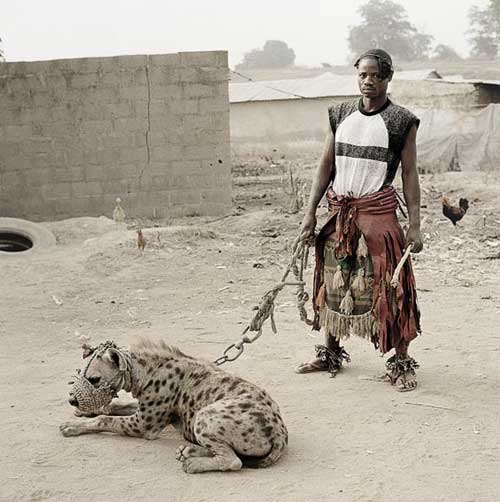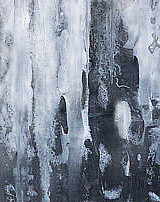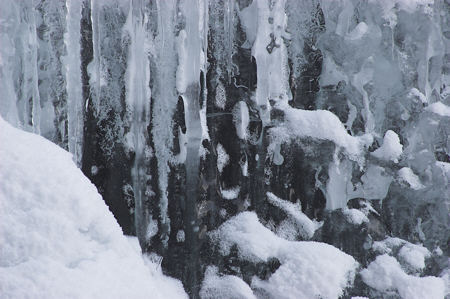Fractal patterns of mudflats at low tide,
winter solstice
Artistic pretexts
I was over at the Yossi Milo gallery the day before yesterday intending to look at their latest photography exhibit that was getting a lot of press in recent times. The exhibit features the journey of a photographer (Pieter Hugo) to Abuja in Nigeria and his chronicling the lives of an itinerant group who are known as the ‘hyena handlers/guides’ (Gadawan Kura in Hausa).

In Pieter’s own words: more… »
Ice Post
Want to get the image up in the face of a computer or web connection problem.

Will say more when the connection stops timing out.
Tonality controls abstraction

Posts from Sunil and from Jay have described their use of Photoshop manipulations. So I thought I’d show a bit of what happens — or could happen — to one of my images when I process it. To keep it simple, I’ll discuss a single photograph taken last weekend, a close view of a portion of frozen Lost Creek Falls in Yellowstone. Above is the “straight” version, i.e. how it looks when the simplest possible treatment with “no” adjustments is applied. The lighting from the partly blue sky gives it the bluish cast. My usual conversion to black and white, with contrast and brightness adjustment (“curves”) yields the result below. By “usual” I mean usual approach; the actual adjustments are different for each image.
Jack on the Fence
A nice thing about A&P is that one can violate a cardinal rule and show unfinished work. And this is certainly the season for such.
There is a benefit to all the wind and snow in that it forces me indoors with its limited space and ventilation where I am obliged to work in a more preliminary mode. This time around it’s combinations of sticks as I try to stay on topic with the linkage theme.
As a follow up to the Christmas lights that I posted, I kept putting scissor jack units together, seeking to create a spiral effect that might either sit or hang. As matters sit it is hanging – for now.

historic day
For our Halibut series:
Two more web sites to waste your time on:
www.bigthink.com including bigthink.com/arts-culture
and www.wiki.com.
Looking Behind The Queer Eye
I’ve always been somewhere between irritated and offended by Queer Eye For The Straight Guy. Did it perpetuate offensive stereotypes: the clueless lives-like-a-pig badly groomed straight man and the flaming nobody makes it as pretty as a poof gay boy? And then there is that nagging feeling–as it is with all stereotypes, that both stereotypes are built on a grain of truth.
Regarding homosexuality, the world seems focused on two very queer questions.
The first question suggests that homosexuals differ from heterosexuals in no other way than the sex act. Are we just like everybody else, differing only in our choice of sex partner? Or does sexual orientation, like gender, cause us to think and feel differently in many ways other than just sexual attraction? And is this particularly obvious when it comes to the visual and performing arts? Is there, in fact, a Queer Eye?
img src=”http://rjr10036.typepad.com/proceed_at_your_own_risk/images/2008/01/06/bret_and_stephen_070.jpg” align=”middle” />
The second question, of course, is the raging controversy: nature vs. nurture?
But there is a third “elephant in the room” question that is mostly ignored; Are gay men generally more creative than everyone else or is this one big fat whopping stereotype?
The compelling implication of the creativity question is that if the answer is yes and we are generally more creative and more sensitive to our environment, than the first two questions make no sense–unless you actually believe that talent is a chosen and subsequently learned skill.
Does Bravo Television’s Queer Eye For The Straight Guy play to an offensive Jim Crow kind of stereotype or do queer men bring a greater sense of style and taste to the physical world?
img src=”http://rjr10036.typepad.com/proceed_at_your_own_risk/images/2007/12/31/queer_eye.jpg” align=”middle” />
Do gay men naturally dominate the creative arts or are we simply more comfortable being out and loud in this more permissive and expressive environment? Have anthropologists, sociologists, psychologists and homo-ologists built a house of cards on a very false premise? What is the queer eye? Is the queer eye born of and nurtured by the closet? Obviously, our sexual tastes coupled with the repressed and confined boundaries of the closet drive a much keener awareness and sensitivity to human behavior and the environment in general. Visual details from color to hand gestures become much more important to the queer boy than to the straight boy. And survival is the driving force. The wrong hand gesture in an ordinary school yard can earn you a bloody nose. A pink shirt in high school announces “fag” to some, “pride” to others.
During very early stages of childhood development, queer boys necessarily become superior observers, consummate actors and very creative creatures. Even within your own family, you catch on quickly to the fact that you are seeing the world through different eyes than almost everyone else around you. Many artists will tell you that pain and “experience” are the greatest muses–and who feels more pain and has more “life experience” than a queer?
img src=”http://rjr10036.typepad.com/proceed_at_your_own_risk/images/2007/12/31/survivor.jpg” align=”left” />Obviously, the same cannot be said for other minorities–persecuted or otherwise. We are unique in that we are born a minority even within our own ethnic, cultural or religious minorities. While any queer Jew or African American will tell you that he or she acquired useful survival tools as a Jew or African-American that apply to queer survival, the queer needed to take those survival tactics and strategies to an entirely new level not even remotely imagined by his or her immediate blood family.
So let us ask another obvious question. In order to survive, the queer must call upon inner resources and behavioral skills not even remotely part of the lives of most heterosexuals. Survival compels the queer to hone senses and sensitivities far beyond the needs of the average mainstream heterosexual. Is that the fuel behind enhanced creativity and sensitivity? Is that the origin of the Queer Eye?
So here we are circling back to nature vs nurture.
And the debate rages on. One prominent thinker attributes queer creativity to a form of impaired maturation. Another suggests that homosexuality forges a stronger relationship between mother and infant, which some science now suggests may be the evolutionary basis of art. Does the disproportionate number of gay men in the arts suggest an unusual and extraordinary capacity to speak the language of maternal love?
Are we retarded (but in a loving way)?
Internationally respected scientist, artist and author (The Naked Ape) Desmond Morris, who became a bestselling author by applying zoology to explain human behavior, has now utilized the same techniques to put forward an explanation for homosexuality.
In his latest book, The Naked Man, Morris theorizes that men are “made gay” because they retain infantile or juvenile characteristics into adulthood – a phenomenon known as neoteny. img src=”http://rjr10036.typepad.com/proceed_at_your_own_risk/images/2007/12/31/desmond_morris_2.jpg” align=”right” />
According to this theory, gay men also tend to be more inventive and creative than heterosexuals because they are more likely to retain the mental agility and playfulness of childhood. Intuitively, that sounds and feels “right”.
“Gays have in general made a disproportionately greater contribution to life than non-gays,” said Morris, who is also a noted artist. “The creative gay has very much advanced Planet Earth.”
“The playfulness of childhood is continued with certain people into adulthood. This is very much a positive. Adult playfulness means that certain people, often a fairly large proportion of them gay, are more inventive and curious than heterosexuals.”
This new Morris theory has been attacked by Steve Jones, professor of genetics at University College London. “It’s arts faculty science to say that gays are neotenous,” he said. “It’s a stupid idea. Where is the real evidence?” more… »